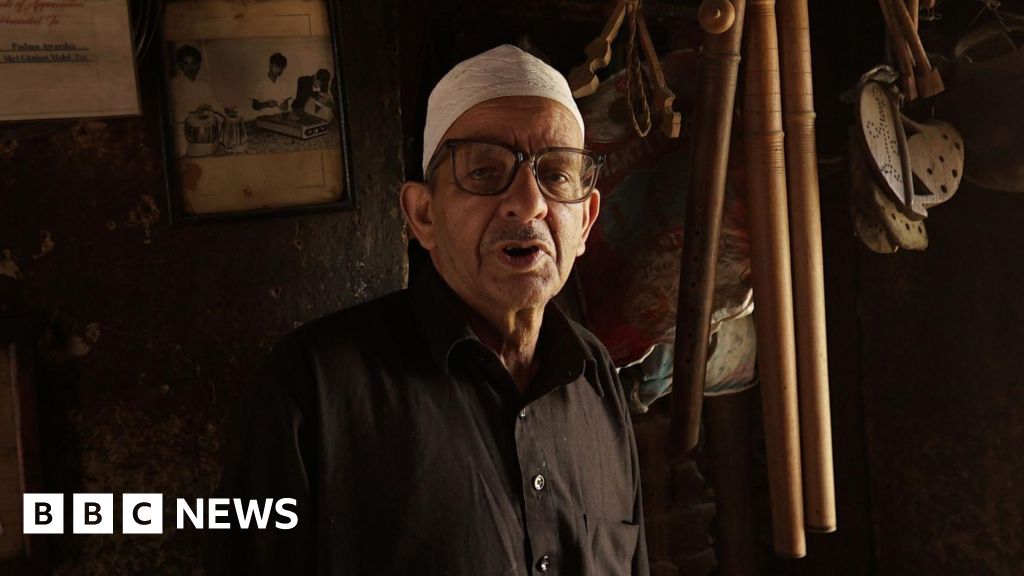【新闻摘要】
克什米尔的音乐"活化石"正在上演最后的独奏!在斯利那加幽暗小巷里,古拉姆·穆罕默德·扎兹成了当地最后一位手工制作桑图尔琴的匠人。这位七代制琴世家的传人,如今的工作室冷清得像被按了静音键——年轻人都去听嘻哈了,谁还稀罕这种需要"五年等一块木头,三个月调一根弦"的老古董?最讽刺的是,这位2022年获得印度第四高平民荣誉的匠人,墙上挂着与音乐大师的合影,手里却连个学徒都招不到。网友感叹:这哪是手艺传承,分明是"非物质文化遗产"在单曲循环《凉凉》啊!
The last custodian: A Kashmiri artisan's battle to save a musical legacy
最后的守护者:克什米尔匠人拯救音乐遗产之战
Adil Amin Akhoon Ghulam Mohammed Zaz is Kashmir's last traditional hand maker of the santoor instrument
阿迪尔·阿明·阿洪:古拉姆·穆罕默德·扎兹是克什米尔最后一位传统桑图尔琴手工匠人
In the quiet, narrow lanes of Srinagar in Indian-administered Kashmir, a small, dimly lit workshop stands as one of the last holdouts of a vanishing craft.
在印控克什米尔斯利那加幽静的窄巷里,一家光线昏暗的小作坊成为消失工艺的最后堡垒
Inside the shop sits Ghulam Mohammed Zaz, who is widely believed to be the region's last artisan who can make the santoor by hand.
店主古拉姆·穆罕默德·扎兹被公认为当地最后一位能手工制作桑图尔琴的匠人
Santoor is a trapezoid-shaped stringed musical instrument, similar to a dulcimer, which is played with mallets.
桑图尔琴是梯形弦乐器(类似扬琴),用琴槌演奏
It is known for its crystalline bell-like tone and has been Kashmir's musical signature for centuries.
以水晶铃铛般的音色闻名,数百年来是克什米尔的音乐标志
Mr Ghulam Mohammed belongs to a lineage of craftsmen who have been building string instruments in Kashmir for over seven generations.
古拉姆·穆罕默德出身制琴世家,家族在克什米尔制作弦乐器已逾七代
The Zaz family name has long been synonymous as the makers of the santoor, rabab, sarangi and sehtar.
扎兹家族长期以制作桑图尔琴、拉巴布琴、萨朗吉琴和塞塔尔琴闻名
But in recent years, the demand for handcrafted instruments has dwindled, replaced by machine-made versions that are cheaper and quicker to produce.
但近年来手工乐器需求锐减,被更廉价快捷的机制品取代
At the same time, music tastes have changed, adding to the decline.
同时音乐品味变迁加速了衰落
"With hip hop, rap, and electronic music now dominating Kashmir's soundscape, younger generations no longer connect with the depth or discipline of traditional music," says Shabir Ahmad Mir, a music teacher.
音乐教师指出"嘻哈和电子音乐主导下,年轻人不再理解传统音乐的深度与章法"
As a result, demand for the santoor has collapsed, leaving craftsmen without apprentices or a sustainable market, he adds.
导致桑图尔琴需求崩溃,匠人既无学徒也无稳定市场
Adil Amin Akhoon Mr Ghulam Mohammed received India's fourth highest civil honour in 2022
阿迪尔·阿明·阿洪:古拉姆·穆罕默德2022年获印度第四高平民荣誉
In his century-old shop, Mr Ghulam Mohammed sits beside a hollow block of wood and worn iron tools - the quiet remnants of a fading tradition.
在百年老店里,古拉姆·穆罕默德守着中空木料和锈蚀工具——逐渐消逝传统的沉默见证
"There is no one left [to continue the craft]," he says."I am the last."
"无人继承这门手艺,我是最后一人"
But it wasn't always this way.
但昔日并非如此
Over the years, renowned Sufi and folk artists have played santoors handcrafted by Mr Ghulam Mohammed.
多年来著名苏菲派和民谣艺术家都演奏过他制作的桑图尔琴
A photo in his shop shows maestros Pandit Shiv Kumar Sharma and Bhajan Sopori performing with his instruments.
店内照片显示大师们用他制作的乐器演奏
Believed to have originated in Persia, the santoor reached India in the 13th or 14th century, spreading through Central Asia and the Middle East.
桑图尔琴据信源自波斯,13-14世纪经中亚和中东传入印度
In Kashmir, it took on a distinct identity, becoming central to Sufi poetry and folk traditions.
在克什米尔形成独特风格,成为苏菲诗歌和民俗传统的核心
"Originally part of Sufiana Mausiqi (an ensemble music tradition), the santoor had a soft, folk-like tone," says Mr Mir.
"最初作为苏菲合奏乐传统部分,桑图尔琴具有柔和的民间音色"
Pandit Shiv Kumar Sharma later adapted it for Indian古典音乐, he says, by adding strings, redesigning bridges for richer resonance and introducing new playing techniques.
大师通过增加琴弦、改良琴码和革新演奏技法将其引入印度古典音乐
Bhajan Sopori, who has Kashmiri roots,"deepened its tonal range and infused it with Sufi expression", adds Mr Mir, helping cement the santoor's place in Indian classical music.
克什米尔裔大师"拓展音域并注入苏菲表达",巩固其在印度古典音乐中的地位
Another photo shows Mr Ghulam Mohammed receiving the Padma Shri from President Droupadi Murmu in 2022, honoured for his craftsmanship with India's fourth-highest civilian award.
另一张照片记录他2022年获印度第四高平民荣誉莲花士勋章
Getty Images Mr Ghulam Mohammed crafting a traditional santoor
盖蒂图片社:古拉姆·穆罕默德制作传统桑图尔琴
Mr Ghulam Mohammed was born in the 1940s in Zaina Kadal, a neighbourhood named after an iconic bridge that once served as the lifeline of commerce and culture in Kashmir.
他1940年代生于以商业文化要道命名的扎伊纳卡达尔社区
Growing up, he was surrounded by the sounds and tools of his family's trade.
在家族工艺的声音和工具环绕中长大
Health issues forced him to leave formal education at an early age and that is when he began learning the art of santoor-making from his father and grandfather - both master craftsmen themselves.
因病辍学后随父祖学习制琴技艺
"They taught me not just how to make an instrument but how to listen - to the wood, the air and the hands that would play it," he said.
"他们教我不仅制作乐器,更要聆听木材、空气和演奏者的手"
"My ancestors used to be summoned by the courts of local kings and were often asked to build instruments that could soothe hearts," he says.
"先祖常被王宫召见制作抚慰心灵的乐器"
In his workshop, a wooden bench lined with chisels and strings lies beside the skeletal frame of an unfinished santoor.
工作室内,排列着凿子和琴弦的木凳旁是未完工的琴架
The air smells faintly of aged walnut wood, but there is no machinery in sight.
空气中飘着陈年核桃木香,不见机械踪影
Mr Ghulam Mohammed believes machine-made instruments lack the warmth and depth of those crafted by hand and the audio quality comes nowhere close.
他认为机制乐器缺乏手工的温度与深度,音质远不能及
Making a santoor is a slow, deliberate process, the craftsman says.
制作桑图尔琴是缓慢而精细的过程
It starts with selecting the right wood, aged and seasoned for at least five years.
从选料开始——木材需陈化至少五年
The body is then carved and hollowed for optimal resonance, and each of the 25 bridges is precisely shaped and placed.
琴身经雕刻掏空以获得最佳共鸣,25个琴码需精确塑形定位
Over 100 strings are added, followed by the painstaking tuning process, which can take weeks or even months.
安装超百根琴弦后是耗时数周甚至数月的调音
"It is the craft of patience and perseverance," he says.
"这是耐心与坚持的技艺"
Getty Images The santoor has been Kashmir's musical signature for decades
盖蒂图片社:桑图尔琴作为克什米尔音乐标志已数十年
The artisan charges between 50,000 to 100,000 rupees ($600-$1,200) per instrument.
每把琴售价5-10万卢比(约合600-1200美元)
But with few buyers, he now makes just three or four santoors a year.
但因买家稀少,现每年仅制作三四把
"Earlier, I would get orders from across India and even abroad. Now, it's mostly museums or collectors," he says.
"过去订单来自全印乃至海外,现在多是博物馆或收藏家"
Local schools have stopped teaching santoor, further shrinking its reach.
当地学校停授桑图尔琴课程进一步缩小其影响
"Even if someone wants to learn, where will they find a teacher or a good instrument?" asks music student Aamir Hussain.
音乐系学生感叹"想学琴也找不到老师和好乐器"
Mr Ghulam Mohammed's two sons chose careers in medicine and engineering.
古拉姆·穆罕默德的两个儿子选择从医和工程行业
"They saw no future in this dying craft," he says matter-of-factly.
"他们在这门没落手艺中看不到未来"
The state government has offered to fund a workshop to train apprentices.
邦政府提议资助作坊培训学徒
"But who will come to learn a skill with no market?" he asks.
"但谁愿学没有市场的手艺呢?"
Some suggest mass-producing cheaper santoors to revive interest.
有人建议量产廉价版以重燃兴趣
"That would kill the soul of the instrument," Mr Ghulam Mohammed retorts.
古拉姆·穆罕默德反驳"那会扼杀乐器的灵魂"
A few young musicians are trying to blend santoor with contemporary genres.
少数年轻音乐人尝试将桑图尔琴与现代音乐融合
"It's our heritage - we can't let it disappear," says fusion artist Zubair Ahmed.
融合派艺术家表示"这是不能任其消失的遗产"
The craftsman's eyes light up when he talks about the santoor's unique sound.
谈起桑图尔琴独特音色时匠人眼中有光
"Each note carries the whispers of our ancestors," he says.
"每个音符都承载着祖先的絮语"
His gnarled hands gently pluck a string, releasing a shimmering cascade of notes.
他粗糙的手指轻拨琴弦,流泻出粼粼音波
For a fleeting moment, the dusty workshop transforms into a concert hall.
尘埃遍布的作坊瞬间幻化为音乐厅
Then silence descends again.
而后重归寂静
The last custodian returns to his workbench.
最后的守护者回到工作台前

